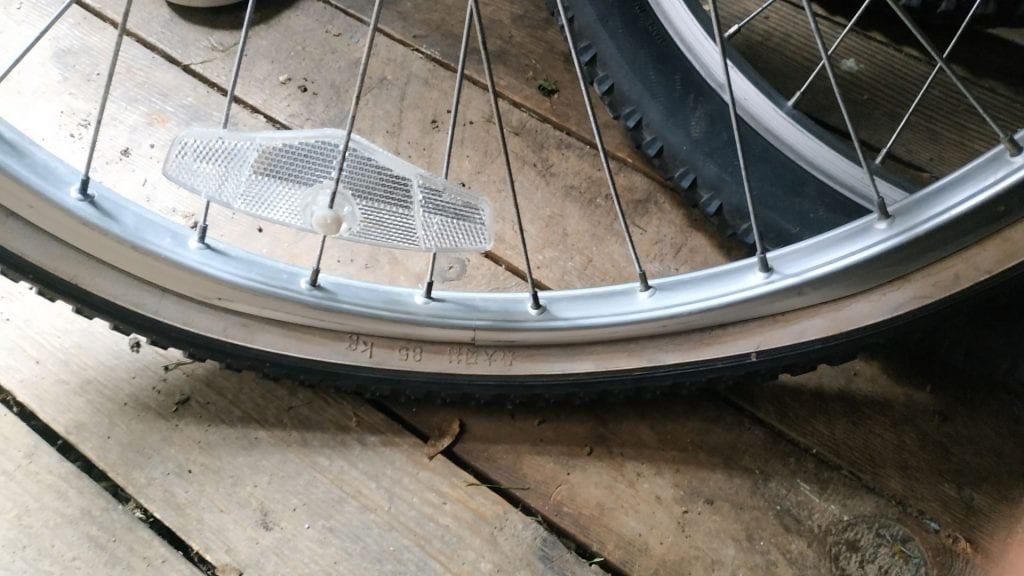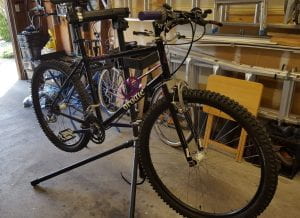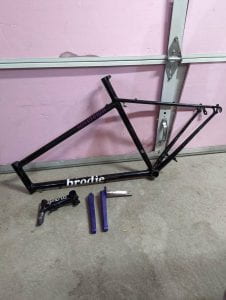Progress Report
Welcome to the fifth post of this project, which I would like to preface by saying that everything is coming together! It has been a wild ride and now I will share what I have been up to these past few weeks.
Once again, I’ve had two mentor meetings, each extraordinarily valuable. At the first one (really the seventh), I learned about wheel truing from my mentor. Here is a video from our meeting.
At that meeting, we determined that the Mongoose bike has a wheel that cannot be trued; its rim is alarmingly bent.

I also learned the gist of how to wash a bike, and we discussed how I shall present myself at in-depth night. I expressed how I feel quite apprehensive about it, but David reassured me that I know what I’ll be talking about, so there is no reason for me to feel nervous. Speaking of that, at in-depth night, I am planning to start with telling anybody who comes by, how they can keep their bike out of their bike shop. Then they can ask me questions and I can go into areas on the bike that they are interested in.
Then, at the last meeting that we had on Easter Sunday, I had the opportunity to partake in something wonderful: I helped to disassemble a whole bike! Here are pictures:



And a video of the meeting/disassembling the bike (but it got cut off because of phone storage issues, so only part of the process was captured).
Before I say anything else, I should mention the super cool history of this bike here. There are a lot of people online “drooling over it,” in the words of the owner of this bike (a friend of David’s). The frame was built by Paul Brodie (a famous frame builder) and this was the 181st bike that Brodie built. Either way, throughout disassembling, I learned that this bike also has a lot of rare parts, for example, the rear brake is a rim brake but it’s at the bottom of the wheel/frame rather than on top of the wheel! A lot of the bolts were also SAE-sized, meaning they aren’t metric like most bikes are, and the bottom bracket is worth $2000! That I got to help disassemble it is crazy. Anyway, the reason why we are disassembling it is that the bike owner wants to paint the frame (it’ll go from what it is now, black, to light metallic blue), and to do that, all the parts need to be taken off so it can be sent off to be powder-coated (where an electric current is put through the bike so when the powder is dusted over it, the powder gets attracted to the current and sticks dead onto the frame—superior to normal paint, you bet!).
This was a really sweet experience for me that David and the owner of this beautiful bike were kind to let me in on because, first, I have a much better idea of how all the parts on a bike fit together now! I saw parts of a bike that I had never seen before but that I had always wanted to learn about, and that David and I wanted to go into, such as the bottom bracket assembly and the headset, so this was perfect. Perhaps a really big lesson I took away from this is the importance of greasing parts before putting them back together, because multiples times I witnessed the two men struggling to loosen and take off parts that had not been greased, making the parts dry and hard to disassemble; a mallet was produced, there was hammering, and the sight of pulling, wiggling, and grunting at stuck parts between each other was, I guess, quite a sight! Thus, when we are going to put the bike back together again, we will make the job of the next person who has to take the bike apart easier by greasing everything. Speaking of that, it will take about a month for the frame to come back all nice and powder-coated, which I think will probably still be within the timeline of this project. Even if it is not, David said I will get to help put the bike together again too, even more exciting! The second reason why this was a very valuable experience is in my learning contract, I did state that the challenge/most rigorous test of my new skills that I think I can manage is to see if I can disassemble a whole bike on my own and put it back together again in an attempt to improve its condition. Getting to do this with my mentor is helpful and lines up perfectly that way because I am planning to start my challenge around Mother’s Day in May. Also, something else that matches up perfectly, I can disassemble that Mongoose bike with the un-true-able wheel! I can’t wait. If I end up thinking that the Mongoose bike can indeed be saved, I might just buy a new wheel and it will be saved.
The other day at the end of Math class, Mr. S brought up to me how there is a cool bike shop in Vancouver called Our Community Bikes—it sounds like the place of my bike repair dreams—it “is a full-service repair shop, bicycle recycling depot and an educational workspace for people who wish to repair their own bikes or learn how to do so. Our shelves and bins are stocked with new and used parts, and our mechanics do their best to help,” as written on its Facebook page. I would love to go there sometime soon, probably on a weekend in May.
What else I did:
On my own, I fixed the bike chain of the Nevada. Please see these videos.
I also untied a basket from the Mongoose if that counts.
Finally, I worked on the grips on my bike! Success—they finally don’t twist anymore! To tell the story of how I finally fixed my grips, I went on YouTube and watched a bunch of videos all promoting different tricks to put grips on. Many of them used fancy conventions such as air compressors (my mentor said he has one of them 🙃) or hairspray, which I did not have until I came across this amazing video that illustrated the method of using zip ties. I asked my friend for some and set to work. I also had to borrow an Exacto knife from the woodwork room to cut an end of the grip off to make the zip tie method work. Fun stuff!
Next steps:
Right now, the very next task I am going to undertake is to wash the Nevada bike. I borrowed brushes from David yesterday and hopefully, the weather will clear up a bit today. I’ll catch you next time with a report on that one! After washing it, I will repair that bike’s brakes. I am going to fix that bike up; it is my focus right now and the deadline for me to fix that bike is by Mother’s Day so afterwards, I can have time to disassemble and reassemble the Mongoose, go to Our Community Bikes, prepare my presentation for In-Depth Night, and have a few more meetings with David to learn the next two sub-skills on my list. Namely, I am currently interested in learning more about telling the difference between a cassette and a freewheel so that I can try cleaning a cassette, and how to use a CO2 canister (for fixing flat tires on the road)! I have also planned to learn about maintaining the suspension on my bike and other interesting bottom brackets and such assemblies.
Obstacles/Frustrations
No specific obstacles or frustrations come to mind; it does not appear like I have encountered any these past few weeks. Perhaps this is because I have been able to overcome challenges I encounter by trying to think like a good mechanic. For example, when I was straightening out the kinks in the chain, there were so many stiff links that I had to resort to using tons of WD-40 instead of using precious chain oil as David had prescribed. Or, maybe untying that basket was a challenge I overcame, because I had to go online to get the idea to use bobby pins and paper clips and my knitting needles to pick at the knots instead of using my fingers. Also, I am very happy with how the grips turned out because it was somewhat of a challenge/obstacle/frustration that I had been battling with for quite a while. I was riding around for a while without one of my grips on because I couldn’t find the time to fix it. Once again, going online to search for solutions was the turning point in solving my problem.
Reflection Questions & Mentor
1. What kinds of learning opportunities does the mentor provide to expose you to new learning?
An example of a learning opportunity that David provided to me to expose me to new learning was letting me know about his friend who wanted to disassemble and powder-coat his bike and telling me that I can come and watch/help. This exposed me to new, in-depth learning of how the parts of a bike go together!!
2. What kinds of learning opportunities exist to reinforce new learning?
I can always message David to ask for help or answer a question about anything bike-related, which is a learning opportunity that exists for me to reinforce new learning because if I am unsure about something that we talked about at a meeting, I can ask for confirmation. For example, that time when I didn’t know what was wrong with the front derailleur after our meeting on derailleurs, I messaged David and within 15 minutes I was at his garage and the bike was in the stand and we were figuring it out together.
3. What kinds of opportunities exist that might accelerate learning?
This is not an opportunity that my mentor is particularly providing, but visiting Our Community Bikes might accelerate my learning because I can meet other people who are also passionate about bike maintenance and there are lots of resources (mechanic workers, tools, supplies) there that could do me good. The other opportunity that exists is…Trek is hiring. If I somehow got a job there, that would certainly accelerate learning because I’d be around, talk about, and work with bikes for all my time there. Read more about this in the next question below!
4. When you get together what do you talk about?
When we get together, we generally talk about bike stuff. We are focused on working through our agenda and David is passing his knowledge of the skill onto me.
Other than that, we sometimes also talk about what we’ve been up to or plans for the future, for example how he is building some set for Evergreen Theatre now, and I talked about how I had a play at school for Drama too. Likewise, I talked about my upcoming trip, and David told me about the Kidsport sports equipment sale next weekend. Oh, we also talked about…how Trek gave me a “we’re hiring” card once when I was there! This reminds me that I need to look into that. David reminded me at one of our meetings and we talked about how cool it would be if this project sort of culminated in me landing a job (I could be one of the people on the floor, not necessarily a mechanic yet) at Trek! David’s wife, who used to work at the Ministry of Labour, even searched up for me the minimum age that I am allowed to work there (we concluded that I’m good to go). I am not sure I have enough on my resume for it though.
5. What is going particularly well in your mentoring relationship right now?
I think what is going well is that my mentor is focused and meeting my needs; I am certainly getting what I need. David is much more skilled than I am, and he always gives me information that will help me. For example, when I needed a 15mm wrench to take off the wheels of my bike, but I did not have one, I decided to ask David if I could borrow one. While I was there, he thought to show me something that would be beneficial for me to know: on a bike he had been working on, the customer had brought the bike in, saying that they thought the brake pads needed to be replaced. Turns out, the brake pads are just fine, but they were installed backwards, so David showed me how on some brake pads, there is an arrow inscribed on it which signifies which way it should be installed. Furthermore, David and I are also good at staying focused at meetings and in our interactions. This allows us to dig into what we are doing. For example, while disassembling that bike, we were all super focused on the task and David was explaining everything to me along the way and I was listening attentively.
6. What are you learning about one another?
I am learning about David that he is very facilitating and naturally a great mentor because he wants to explain everything and help me understand what we are covering, and he helps me with any questions I might have. David can also be quite humorous; he sometimes jokes about funny things he has done in the past with bikes (doubling it as a lesson for me!). For example, as he was throwing some used cables into a garbage bin of used parts, he commented, “I always have to make sure I throw these in there because once I gave my wife a flat tire.” Accordingly, I am always impressed when I gain insight into how much experience David has with bikes, and how involved he is with sharing his skills with the community too—throughout his career, with Kidsport, and with me.
Alright, that’s it for today. Undoubtedly, I am enjoying the learning in the moment!
